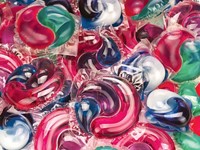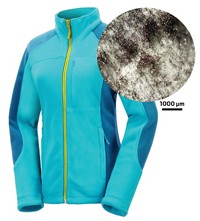Advertisement
Grab your lab coat. Let's get started
Welcome!
Welcome!
Create an account below to get 6 C&EN articles per month, receive newsletters and more - all free.
It seems this is your first time logging in online. Please enter the following information to continue.
As an ACS member you automatically get access to this site. All we need is few more details to create your reading experience.
Not you? Sign in with a different account.
Not you? Sign in with a different account.
ERROR 1
ERROR 1
ERROR 2
ERROR 2
ERROR 2
ERROR 2
ERROR 2
Password and Confirm password must match.
If you have an ACS member number, please enter it here so we can link this account to your membership. (optional)
ERROR 2
ACS values your privacy. By submitting your information, you are gaining access to C&EN and subscribing to our weekly newsletter. We use the information you provide to make your reading experience better, and we will never sell your data to third party members.
Career Tips
Microplastic Beads Pollute Great Lakes
Companies pledge to remove tiny polyethylene scrubbing beads from personal care products
by Cheryl Hogue
September 16, 2013
| A version of this story appeared in
Volume 91, Issue 37

An array of skin care cleansers on the market promise to exfoliate and unclog pores. Some of these skin-scrubbing products contain tiny beads of plastic scattered through a gel or creamy paste. After washing with these cleansers, consumers rinse the soapy stuff—along with its teeny spheres—down the drain, giving nary a thought to what happens to the plastic bits, which are less than 1 mm in diameter.
Now, researchers are finding plastic microbeads in the Great Lakes. They say the miniscule spheres could harm aquatic animals that mistake them for food. Perhaps more ominously, they worry that the plastic balls could help transfer toxic pollutants from the Great Lakes to the food chain, including fish that people eat.
Although these scientists’ studies are not yet published, data from them documenting the presence of microbeads in the Great Lakes have been shared with companies that make personal care products containing the beads. And those firms are responding.
Researchers gathering and analyzing information about plastics in the Great Lakes include a chemist from SUNY Fredonia and scientists from the 5 Gyres Institute, an environmental group working to reduce plastics pollution. Stiv J. Wilson, policy director of the 5 Gyres Institute, says his group provided the data to U.S. companies that make skin cleansers or other personal care products containing plastic microbeads. Johnson & Johnson, L’Oréal, and Procter & Gamble in recent months have pledged to phase out polyethylene spheres in their skin cleansers.
But these firms weren’t the first personal care product makers to make this move. Leading this trend was U.K.-based Unilever. Under pressure from European environmental activists, Unilever in December 2012 announced it is working to eliminate plastic microbeads in the next three years. Meanwhile, 5 Gyres Institute says Colgate-Palmolive has also pledged to phase out microbeads from toothpaste and other products, but the company did not respond by C&EN’s deadline to confirm this.
In statements that either announced or confirmed plastic microbead phaseouts, J&J, L’Oréal, P&G, and Unilever do not say why or when they initially decided to add plastic beads in products designed to be released into water.



The discovery of microbeads in the Great Lakes started with a hunch by an environmental chemist. Study after study has documented the presence of large amounts of plastic in the world’s oceans, points out Sherri (Sam) Mason, an associate professor of chemistry at SUNY Fredonia. “If we find it in the oceans, we’re probably going to find it in the Great Lakes,” she tells C&EN.
She was part of a team of researchers who set out in the summer of 2012 to investigate that premise. In work funded by the Burning River Foundation, an Ohio nonprofit organization that focuses on protecting aquatic resources, they cruised Lakes Superior, Huron, and Erie to collect samples from the surface waters. To do this, they attached a net with 0.33-mm openings to their vessel.
The researchers then divided the plastics they’d gathered into three groups according to the longest dimension, Mason says. One group consists of pieces larger than 5 mm. A second is composed of particles between 1 and 5 mm. And the third category, microplastics, is bits that are less than 1 mm on their longest dimension and as small as 0.355 mm. Mason is focused on studying this last group.
Every piece of microplastic collected in 2012—there were thousands—was examined using a scanning electron microscope and energy-dispersive X-ray spectroscopy, Mason says. “This is some tedious work,” she notes. Some of the tiny bits are jagged splinters from larger pieces of plastic. But most of them are spherical, suggesting that they were released into the environment as pellets, she says. What’s more, many of them are the same size and color—including white, blue, green, or orange-red—as the small beads used in a number of personal care products, Mason says.
The analysis of the 2012 plastics collection in the lakes is described in a paper under review at Marine Pollution Bulletin. According to Wilson, who is a coauthor, the paper would be the first to document plastic pellet pollution in the Great Lakes.
Of the plastics collected during the 2012 research cruises, about 80% of the pieces are less than 1 mm in size, Mason says. Although the amount in each sample varied widely in all lakes studied, the researchers estimated that they found a relatively low concentration of microplastics on Lake Superior, which has the least heavily settled watershed of the Great Lakes. The density of microplastics found on Lake Superior’s surface averaged roughly 2,400 particles per km2. At the other end of the spectrum, Lake Erie’s surface had the highest density, averaging somewhere around 80,000 particles of microplastic per km2. Lake Erie’s watershed has the most people and industry of the Great Lakes and this could help account for its higher numbers of plastic particles, Mason says.
Circulation of water through the Great Lakes system could also be a factor in surface density of microplastic pieces, Mason points out. Water from Lakes Superior, Michigan, and Huron eventually moves through Lake Erie on the way to the Atlantic Ocean. This means that the plastics near the surface of those three lakes could move with the water as it makes its journey to the sea. Lake Erie drains via Niagara Falls into Lake Ontario, which empties into the St. Lawrence River, and that waterway flows into the Atlantic. Researchers collected plastics in Lake Ontario for the first time during summer 2013, and these pieces are undergoing scrutiny now.
The study of the 2012 samples did not include identifying the type of plastic or plastics in the beads, Mason says. But particles collected in the summer of 2013 in Lakes Erie, Ontario, and Michigan, in an effort funded by the Illinois-Indiana Sea Grant and the Burning River Foundation, will undergo analysis to determine their chemical compositions, she adds.
The discovery of microbeads in the Great Lakes has raised plenty of issues for further research. “I have a lot of questions I want to investigate,” Mason says, adding that she is collaborating with a number of other scientists to look for answers.
For instance, researchers are planning experiments to determine whether sewage treatment plants discharge tiny plastic spheres, Mason says. Specifically, she and her collaborators are preparing to study effluent samples from plants that discharge into Lakes Erie and Ontario to check for the presence of microplastics.
But at least one personal care product maker dismisses this possibility. In a statement on its microbead phaseout, J&J says, “To date, the science shows that microbeads from personal care cleansers are removed in wastewater treatment systems.”
J&J’s assertion is news to the National Association of Clean Water Agencies, which represents publicly owned sewage treatment plants. The association classifies the tiny plastic balls, which are designed to get washed into drainpipes, as an emerging contaminant, says Chris Hornback, senior director of regulatory affairs for the association. Emerging contaminants are materials entering wastewater, such as pharmaceuticals, that sewage treatment facilities are not designed to remove or break down.
Using technology developed in the 1950s and ’60s, wastewater treatment plants rely mainly on gravity and microbes to eliminate biosolids and other waste products from water before it is disinfected and discharged into rivers or lakes, Hornback says. Mason points out that many treatment plants add flocculating agents to help remove solid materials from wastewater. But bits of plastic don’t tend to flocculate and thus aren’t likely to be captured during treatment, she says. Plastic microbeads tend to float and thus are likely to flow with treated wastewater into aquatic environments, Hornback tells C&EN.
In addition, other research is focused on whether the tiny plastic pellets skimmed from the surface are entering the food chain, Mason says. Scientists collected samples of lake fish during their research cruises this summer and will examine the contents of their stomachs for plastics.
Small fish and zooplankton could be feeding on microplastics because the particles are about the same size as their food. If these animals are ingesting the particles, the plastic could interfere with nutrient uptake or even physically clog their guts, Mason explains.
There is another concern too. Researchers are worried that persistent toxic substances found in the Great Lakes, such as polychlorinated biphenyls, can adsorb to the plastic and be released in the bodies of aquatic creatures that eat the tiny particles. The plastic could serve as a carrier for toxic substances to move into fish, then into those who eat them, including humans and birds, Mason says. Wilson points out that microbeads have a large surface area per volume, a trait exploited in laboratory equipment in which microbeads are used to separate materials or molecules. This could make the plastic spheres found in the Great Lakes efficient carriers of toxic pollutants, he says.
Looking at the issue of microbead contamination from a larger frame of reference, Wilson says that all plastic pollution in oceans and lakes is a problem. But the addition of tiny plastic spheres to personal care products designed to go down the drain and into the environment is “egregious,” he says. This reflects a lack of life-cycle analysis that is key to sustainability, he continues. Given this, environmental activists’ campaigns against the use of tiny spheres in personal care products have presented companies with “a pretty serious public relations nightmare,” Wilson asserts. “They recognize this is indefensible.”
Unilever announced its phaseout of tiny plastic spheres in personal care products under pressure from Plastic Soup Foundation, a Netherlands-based environmental group that seeks to curb the amount of plastic in the ocean. Unilever points out in its statement: “The amount of plastic in the marine environment thought to originate from the use of plastic scrub beads in personal care products is considered to be limited compared to other sources.” But given the growing amount and potential impact of these plastic bits, Unilever plans to complete its worldwide phaseout of microbeads by 2015. The company says it is “exploring which suitable alternatives can best match the sensory experience that the plastic scrub beads provide.”
Like Unilever, J&J puts its statement announcing a phaseout of polyethylene microbeads in the context of marine plastic pollution. “The likely sources of microplastics in the oceans are from the breakup of discarded plastic bottles and bags,” J&J says. Given consumers’ concerns, it says, “We want our beauty and baby care products to reflect consumers’ current and future needs so they will always have complete peace of mind when using our products.” The company says it is assessing the environmental safety of “a promising alternative” to the polyethylene spheres.
L’Oréal, a third company phasing out microbeads, owns The Body Shop, a brand of personal care products marketed as socially and environmentally conscious. Wilson says 5 Gyres found microbeads in The Body Shop items. L’Oréal asserts it “is committed to ensuring that all of our products have the best-in-class environmental profile” and conducts research on the impacts of its items on aquatic ecosystems. L’Oréal says it won’t develop new products using polyethylene microbeads as exfoliants and “the company favors substituting them in its existing formulae whenever possible.”
A P&G spokeswoman tells C&EN that her company will replace polyethylene microbeads “as soon as alternatives are available and their suitability is absolutely certain.” The company intends to phase out the beads globally over the next few years, with full elimination no later than 2017.
As these firms work to terminate their use of microbeads, consumer pressure on companies to phase out the teensy plastic balls in personal care products is poised to grow worldwide.
Plastic Soup offers a smartphone app called “Beat the Microbead.” With it, consumers can scan the bar code on a product and find out if it contains the tiny plastic spheres. The app relies on a database the group has assembled by purchasing dozens of personal care products and checking them for the presence of microbeads. Wilson points out that determining whether a product contains microbeads can be done easily by diluting the product and passing it through a coffee filter to capture any pellets.
The app was initially developed for the European market. Maria Westerbos, director of Plastic Soup, tells C&EN that the group will roll out an expanded, more global version of the free app in early October.
Wilson’s hope is that microplastic spheres intentionally added to personal care products will soon become a thing of the past. He says, “This is an instance of a poor design and a solvable problem.”





Join the conversation
Contact the reporter
Submit a Letter to the Editor for publication
Engage with us on Twitter